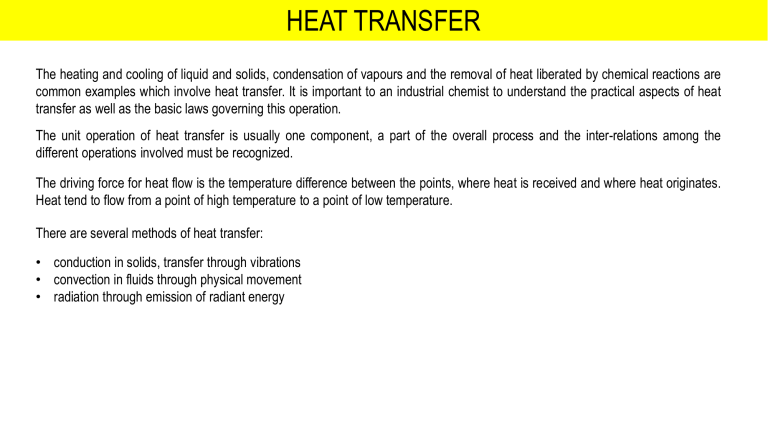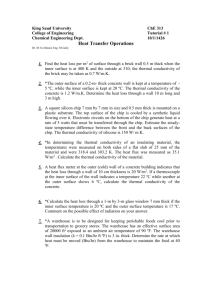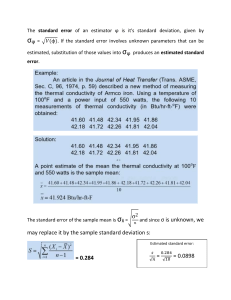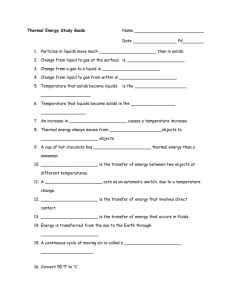Heat Transfer Principles: Conduction, Convection, Radiation
advertisement

HEAT TRANSFER The heating and cooling of liquid and solids, condensation of vapours and the removal of heat liberated by chemical reactions are common examples which involve heat transfer. It is important to an industrial chemist to understand the practical aspects of heat transfer as well as the basic laws governing this operation. The unit operation of heat transfer is usually one component, a part of the overall process and the inter-relations among the different operations involved must be recognized. The driving force for heat flow is the temperature difference between the points, where heat is received and where heat originates. Heat tend to flow from a point of high temperature to a point of low temperature. There are several methods of heat transfer: • conduction in solids, transfer through vibrations • convection in fluids through physical movement • radiation through emission of radiant energy HEAT TRANSFER BY CONDUCTION: FOURIER’S LAW The instantaneous rate of heat transfer through a homogenous body by conduction is directly proportional to the temperature difference driving force across the body, to the cross sectional area of the body through which the heat flows and inversely proportional to the thickness of the body. dQ dT = −kA dt dx where dQ/dt = instantaneous rate of heat transfer, A = cross sectional area of body perpendicular to the direction of heat flow, dT/dx = rate of change of temperature, T with respect to the length of the heat transfer flow path, x and k = thermal conductivity of the material through which the heat is flowing (thermal conductivity of a homogenous substance depends on its temperature and varies linearly). STEADY FLOW OF HEAT IN HOMOGENOUS BODIES In most industrial processes, heat is transferred from one point to another under steady conditions of temperature difference, length of heat flow path and cross sectional area. In such cases, the Fourier’s equation is modified to: Q ∆T = −kA =𝑞 t x where Q = total amount of heat transferred in time, t. EXAMPLE Assume one wall of a furnace is 8 in. thick and is made of brick having an average thermal conductivity of 2.2 Btu/hr ft °F over the temperature range involved. The inner side of the furnace has a temperature of 1700°F and the temperature of the outer side is 700°F. Assuming a wall area of 80 ft2, calculate the amount of heat lost per hour through the wall. SOLUTION 𝑞= 𝑘𝐴 2.2 𝐵𝑡𝑢 ℎ−1 𝑓𝑡 −1 ℉−1 × 80 𝑓𝑡 2 ∆𝑇 = × 1000 ℉ = 262687 𝐵𝑡𝑢 ℎ−1 𝑥 0.67 𝑓𝑡 RESISTANCE TO FLOW OF HEAT When heat flows through a solid by conduction, there is a certain resistance to the flow determined by the thermal conductivity, cross sectional area and the thickness of that particular substance. To obtain any given rate of heat flow, the resistance must be overcome by setting up a certain temperature difference driving force. 𝑥 𝑅= 𝑘𝐴 RESISTANCE IN SERIES If one solid is placed in series with another solid, the resistance to the flow of heat will be greater than it would be for one of the solids alone. If three solids of equal cross sectional area are placed in series when steady flow of heat exists, exactly the same amount of heat per unit time is transferred through each of the solids. HOT SIDE R3 R2 R1 Direction of heat flow Amount of heat per unit time that passes through each of the solids is the same, i.e. 𝑄 𝑡 = 1 𝑄 𝑡 = 2 𝑄 𝑡 = 3 𝑄 𝑡 𝑇𝑂𝑇𝐴𝐿 Rate of transfer through solid 1: 𝑄 𝑡 = 𝑘𝐴 1 ∆𝑇 𝑥 𝑘𝐴 𝑥 = 1 ∆𝑇1 1 Similarly, for solids 2 and 3 ∴ ∆𝑇𝑇𝑂𝑇𝐴𝐿 𝑄 𝑡 1 = + 𝑘𝐴 𝑥 1 𝑄 𝑡 2 + ….. 𝑘𝐴 𝑥 2 Rearranging, we get 𝑄𝑇𝑂𝑇𝐴𝐿 = ∆𝑇 1 𝑘𝐴 𝑥 + 1 1 𝑘𝐴 𝑥 + … 2 EXAMPLE The temperature at the inside surface of an oven is 460°F. The inside wall of the oven is constructed of brick and is 8 in. thick. The thermal conductivity of the brick is 2.2 Btu/hr ft °F. The outside of the oven is covered with a 3 in. layer of asbestos which has a thermal conductivity of 0.11 Btu/hr ft °F. If the outside surface of the insulation has a temperature of 100°F, calculate the amount of heat lost through 2 ft2 of wall in 3 hours. SOLUTION 𝑘𝐴 𝑥 𝑘𝐴 𝑥 𝑏𝑟𝑖𝑐𝑘 𝑎𝑠𝑏𝑒𝑠𝑡𝑜𝑠 2.2 𝐵𝑡𝑢/ℎ𝑟𝑓𝑡 ℉ × 2 𝑓𝑡 2 = = 6.6 𝐵𝑡𝑢/ℎ𝑟℉ 0.67 𝑓𝑡 0.11 𝐵𝑡𝑢/ℎ𝑟𝑓𝑡 ℉ × 2 𝑓𝑡 2 = = 0.88 𝐵𝑡𝑢/ℎ𝑟℉ 0.25 𝑓𝑡 𝑄𝑇𝑂𝑇𝐴𝐿 = 360 1 1 + 6.6 0.88 × 3 ℎ𝑟 = 839 𝐵𝑡𝑢 RESISTANCE IN PARALLEL The total heat transferred through these resistances in a given time is the sum of the heat transferred through each one individually. Thus, for steady flow of heat through homogenous bodies R1 HOT SIDE R2 R3 Direction of heat flow 𝑄 𝑡 = 𝑇𝑂𝑇𝐴𝐿 𝑄 𝑡 + 1 𝑄 𝑡 + 2 𝑄 𝑡 3 𝑄 𝑡 = 𝑘𝐴 𝑇𝑂𝑇𝐴𝐿 ∆𝑇 𝑥 + 𝑘𝐴 1 ∆𝑇 𝑥 + 𝑘𝐴 2 ∆𝑇 𝑥 Assuming that ΔT is the same for each of the three solids 𝑄 𝑡 = 𝑇𝑂𝑇𝐴𝐿 Substituting 𝑅= 𝑘𝐴 𝑥 + 1 𝑘𝐴 𝑥 + 2 𝑘𝐴 𝑥 ∆𝑇 3 𝑥 𝑘𝐴 have 𝑞= 𝑄 𝑡 = 𝑇𝑂𝑇𝐴𝐿 1 1 1 + + ∆𝑇 𝑅1 𝑅2 𝑅3 It is also possible to determine the temperature drop across any one of the solids: ∆𝑇1 = ∆𝑇𝑇𝑂𝑇𝐴𝐿 𝑅1 𝑅1 + 𝑅2 + 𝑅3 3 EXAMPLE A glass window with an area of 6 ft2 is installed in a wooden wall of a room. The dimensions of this wall are 8 by 10 ft. The wood is 1 in. thick and has a thermal conductivity of 0.087 Btu/hr ft °F. The glass is 1/8 in. thick and has a thermal conductivity of 0.40 Btu/hr ft °F. If the inside of the wall and the glass temperature is 90 °F and the outside wall and glass is 30 °F, calculate the total amount of heat conducted through the wall and glass per hour. SOLUTION 𝑄𝑇𝑂𝑇𝐴𝐿 = 𝑘𝐴 𝑥 𝑔𝑙𝑎𝑠𝑠 𝑘𝐴 𝑥 𝑘𝐴 𝑥 + 𝑔𝑙𝑎𝑠𝑠 𝑘𝐴 𝑥 ∆𝑇 𝑤𝑜𝑜𝑑 0.4 𝐵𝑡𝑢 ℎ−1 𝑓𝑡 −1 ℉−1 × 6 𝑓𝑡 2 = = 230.3 𝐵𝑡𝑢 ℎ−1 ℉−1 0.01042 𝑓𝑡 𝑤𝑜𝑜𝑑 0.087 𝐵𝑡𝑢 ℎ−1 𝑓𝑡 −1 ℉−1 × 74 𝑓𝑡 2 = = 77.3 𝐵𝑡𝑢 ℎ−1 ℉−1 0.0833 𝑓𝑡 ∴ 𝑄𝑇𝑂𝑇𝐴𝐿 = 230.3 + 77.3 𝐵𝑡𝑢 ℎ−1 ℉−1 × 60 ℉ = 18456 𝐵𝑡𝑢 ℎ−1 USE OF MEAN AREA AND MEAN TEMPERATURE DIFFERENCE In many types of heat transfer equipment, the cross sectional area varies along the heat flow path and the temperature difference changes from one point to the another. When water flows through straight pipes and is heated by steam condensing on the pipes, the inside area of the pipe wall is smaller than the outside area of the pipe. If cold water comes into the heater, the overall temperature difference between cold water and the steam at the entrance of the heater will be greater than the overall temperature difference between the hot water and the stream at the heater exit. Therefore, to apply the basic heat transfer equations, some type of mean or average values for the area and temperature differences must be employed. Arithmetic mean values: 𝐴𝑚𝑒𝑎𝑛 = 𝐴1 + 𝐴2 𝑇1 + 𝑇2 𝑎𝑛𝑑 𝑇𝑚𝑒𝑎𝑛 = 2 2 Logarithmic mean values: applicable to closed cylindrical bodies of circular sections. 𝐴𝑚𝑒𝑎𝑛 = 𝐴2 − 𝐴1 𝑇2 − 𝑇1 𝑎𝑛𝑑 𝑇𝑚𝑒𝑎𝑛 = 2.3𝑙𝑜𝑔 𝐴2 − 𝐴1 2.3𝑙𝑜𝑔 𝑇2 − 𝑇1 As long as A1 and A2 or T1 or T2 ratios are less than 2, difference between arithmetic and logarithmic mean is less than 5%. EXAMPLE A furnace wall is constructed of fire brick, 10 cm thick. The temperature at the inside of the wall is 800°C and the temperature of the outside of the wall is 40°C. If the mean thermal conductivity of the brick under these conditions is 0.28 W m-1 °C-1, determine the rate of heat loss through 10 m2 of wall surface. SOLUTION 𝑞= 𝑘𝐴 0.28 𝑊 𝑚−1 ℃−1 × 10 𝑚2 ∆𝑇 = × 760 ℃ = 21280 𝑊 𝑥 0.10 𝑚 If the coefficient of heat transfer between the outside furnace wall and air is 14 W m-2 °C-1 and the air temperature is 20°C when the temperature inside the furnace is 800°C. What is the rate of heat loss through 10 m2 of wall surface? (Air acts as an insulator and should reduce the outward heat flow. Consider air as a layer). What is the temperature of the outside furnace wall? SOLUTION FURNACE WALL 800°C AIR LAYER R1 20°C R2 ΔTwall ΔTair 𝑅𝑤𝑎𝑙𝑙 = 𝑅𝑎𝑖𝑟 = 𝑞= 𝑄 𝑡 = 𝑇𝑂𝑇𝐴𝐿 𝑥 0.1 𝑚 = = 0.0357 ℃ 𝑊 −1 −1 −1 2 𝑘𝐴 0.28 𝑊 𝑚 ℃ × 10 𝑚 𝑥 1 = = 0.00714 ℃ 𝑊 −1 −1 −1 2 𝑘𝐴 14 𝑊 𝑚 ℃ × 10 𝑚 1 𝑅𝑤𝑎𝑙𝑙 ∆𝑇𝑎𝑖𝑟 = ∆𝑇𝑇𝑂𝑇𝐴𝐿 + 1 ∆𝑇 = 𝑅𝑎𝑖𝑟 1 1 + 0.0357 0.00714 × 780 ℃ = 131 𝑘𝑊 𝑅𝑎𝑖𝑟 0.00714 = 800 ℃ = 133 ℃ 𝑅𝑤𝑎𝑙𝑙 + 𝑅𝑎𝑖𝑟 0.0357 + 0.00714 If the furnace wall was instead constructed of an inside layer of 8 cm thick firebrick and an outside layer of chrome brick, 2 cm thick, what is the rate of heat loss through 10 m2 of surface, the temperature of the outside wall under these conditions and the temperature between the two layers of brick? (kchrome = 1.38 W m-1 °C-1) Assume that the coefficient of heat transfer between the outside furnace wall and the air does not change. SOLUTION 𝑞= 𝑅𝑏𝑟𝑖𝑐𝑘 = 𝑄 𝑡 = 𝑇𝑂𝑇𝐴𝐿 1 𝑅𝑤𝑎𝑙𝑙 + 1 𝑅𝑐ℎ𝑟𝑜𝑚𝑒 + 1 ∆𝑇 𝑅𝑎𝑖𝑟 𝑥 0.08 𝑚 = = 0.0286 ℃ 𝑊 −1 −1 −1 2 𝑘𝐴 0.28 𝑊 𝑚 ℃ × 10 𝑚 Similarly, Rchrome and Rair = 0.00145 and 0.00714 °C W-1, respectively. 𝑞= 𝑄 𝑡 = 𝑇𝑂𝑇𝐴𝐿 1 𝑅𝑤𝑎𝑙𝑙 ∆𝑇𝑏𝑟𝑖𝑐𝑘 = ∆𝑇𝑇𝑂𝑇𝐴𝐿 ∆𝑇𝑐ℎ𝑟𝑜𝑚𝑒 = ∆𝑇𝑇𝑂𝑇𝐴𝐿 + 1 𝑅𝑐ℎ𝑟𝑜𝑚𝑒 + 1 ∆𝑇 = 𝑅𝑎𝑖𝑟 1 1 1 + + 0.0286 0.00145 0.00714 × 780 ℃ = 674.7 𝑘𝑊 𝑅𝑏𝑟𝑖𝑐𝑘 0.0286 = 800 ℃ = 615 ℃ 𝑅𝑏𝑟𝑖𝑐𝑘 + 𝑅𝑐ℎ𝑟𝑜𝑚𝑒 + 𝑅𝑎𝑖𝑟 0.0286 + 0.00145 + 0.00714 𝑅𝑐ℎ𝑟𝑜𝑚𝑒 0.00145 = 800 ℃ = 31.2 ℃ 𝑅𝑏𝑟𝑖𝑐𝑘 + 𝑅𝑐ℎ𝑟𝑜𝑚𝑒 + 𝑅𝑎𝑖𝑟 0.0286 + 0.00145 + 0.00714


